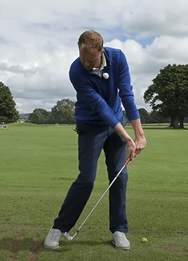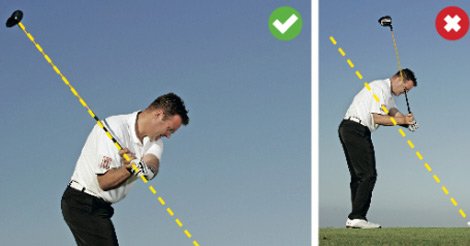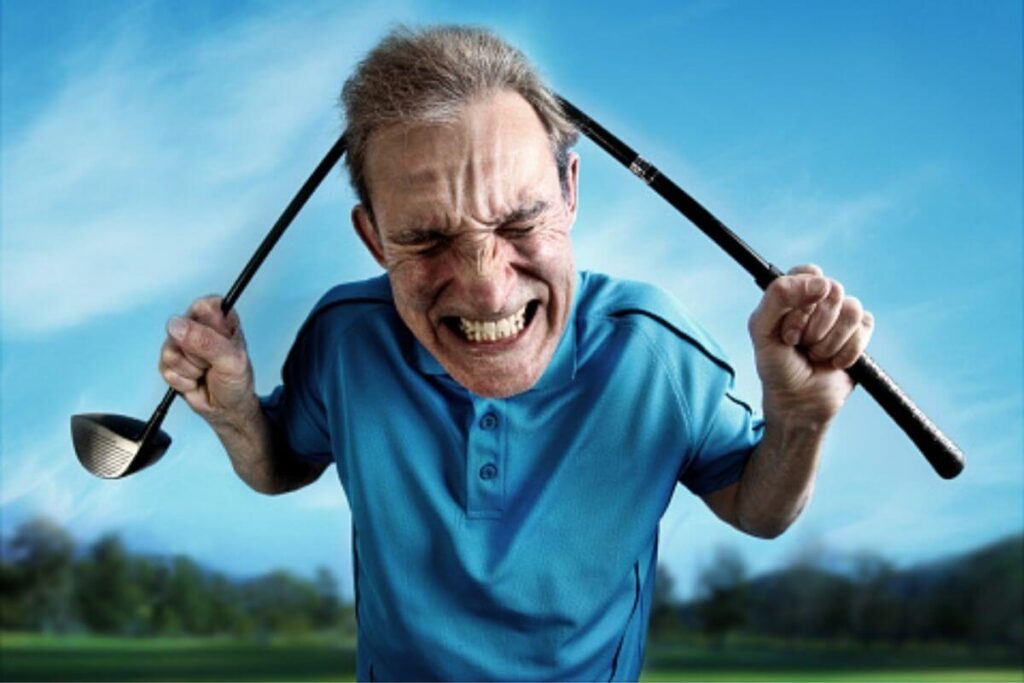Golf is a sport that is by no means an easy walk in the park. It requires knowledge, skills and practice in order to hit your irons properly and consistent. Even the very best of players in the world sometime struggle with consistency as they play golf good one day and bad the next day, so you shouldn’t totally beat yourself up.
Nevertheless, if you are not applying the right techniques during the different phases of your swing, then you are not going to see the results you are looking for.
In this article you will learn some of the most common errors in your golf swing and how to apply the right techniques to fix them. By following these tips, you will see significant improvements in your golf swing. Let’s take a look.
Here are 10 reasons why your golf game sucks:
Table of Contents
10 Common Mistakes That Are Affecting Your Game
1. You Are Casting Your Wrists
Casting is a common golf error that could be affecting your swing. Casting in golf means that you are losing lag as you bring down the club towards impact.
It means that you are flicking the club away when you start the downswing, losing the lag that was created during the backswing. The swing error is similar to that of trying to scoop the ball up from the ground.
Diagram Showing Casting

So what happens to golf shots when you cast? Casting produces poor strikes at the ball that will lack power. Fat and heavy golf shots can also occur at impact. Balls will usually fly higher than normal and won’t go as far as normal, resulting in a loss of distance.
How to fix casting?
In order to fix the cast in your golf swing you need to keep and retain the lag that was created during your backswing. You need to make sure that your hands are ahead of the ball at impact, that your hands are winning the race to the ball.
Hands should be ahead of the ball at impact

A good mental picture to adopt is to try to hit the ball first, to hit down on the ball so that your club strikes the ball before creating a divot.
2. You’re Swinging Over The Top
The next probable cause to why your golf game suck is that you are swinging over the top. Over the top in golf means that your club is travelling ‘over’ (or in front of) what would be the neutral line (or swing plane) during the downswing.
So what ball flight will an over the top swing produce? The swing path associated with an over the top swing is the outside-in. If the angle of the club matches the swing path and aims to the left of the target the ball will fly straight there for a pull.
If the club is open to the path, the ball will start left of the target and spin from left to right, resulting in a fade or a slice. Sometimes, an over the top can even produce a shank.
How do you fix an over the top?
It starts with a good square takeaway, where the club is pointing straight back when the club shaft is parallel to the ground.
Then, as you reach the top of the swing, you must resist turning over your shoulder too early.
Focus on bringing the club down more or less on the same path you used to bring it up. You may even try to lower your hands in order to force an inside-out club path at impact. Hopefully the ball will head more towards the right and may even draw a little.

3. You Are Swaying Your Body
Golfers generally understand that in order to generate power in their golf swing they need to transfer their body weight back during the backswing and forward during the downswing.
However, in some cases, they are not performing this critical part of the swing correctly and are instead suffering from the swaying (sway) golf swing error.
What happens then is that they slide their hips back and forward, resulting in a lack of power, poor low point control and ultimately shot inconsistencies in the form of fat or thin shots.
How To Fix Your Sway
Follow these golf tips in order to fix the sway in your golf swing:
– During the setup, your body weight should be evenly distributed among your two feet.
– As you perform your backswing your weight should move towards your back foot but only in a controlled manner. Critically, some of your body weight should move towards the instep of your back foot but not towards the outside of that foot.
– And your weight should be transferred mostly through the rotation of your upper body, not through the sliding of your hips back and forth.
– At the end of your swing – at the follow through – your body weight should be almost entirely on the front – left – foot. But it should have moved there following a turn and release upper body rotation sequence, not through your hips sliding forward alone.
4. You Pivot In Reverse
In golf, a reverse pivot refers to the swing error in which your weight is transferred in the wrong direction.
So instead of shifting towards the back foot during the backswing and towards the front foot during the downswing a golfer with a reverse pivot will see the opposite happen.
He will incorrectly move his weight towards the front foot during the backswing and towards the back foot during the downswing. This ultimately translates into a loss of distance, poor low point control and overall inefficient golf shots.
A reverse pivot might show up as a consequence of a golfer that is trying to scoop the ball into the air, that is trying to help lift the ball into the air. Sadly, this can not not work since you can’t push the ball up from underneath the ground when it is sitting on said ground.
Getting Rid Of The Reverse Pivot
In order to make sure this swing error is not part of your swing, make a few practice swings in front of a mirror or in front of your phone’s camera.
Notice when you perform your backswing how your body shifts, if at all. If it moves towards your front foot instead of towards your back foot then you are likely a reverse pivoter.
If your body then shifts back towards your back foot during the downswing then you are surely suffering from a reverse pivot.
Make several practice swings in front of your mirror until you see your upper body rotating without sliding back too much during the backswing (a little bit is fine).
Then, watch as your body moves forward during the downswing, impact and ultimately in the follow through where your weight should now be almost entirely on your front foot.
5. You Are Scooping The Ball
Knowing for sure that you are scooping the golf ball can be difficult because the club travels at around 90 miles an hour at impact. And that is where the swing error happens.
Look instead for clues, such as shot inconsistency in alternatively hitting thin shots, fat shots and even very high shots with limited distance.
To fix and stop scooping the ball approach the problem with a solution to a misguided mental approach. Indeed, scoopers of the ball believe that the ball needs to be pushed up into the sky by coming in from underneath it.
But because the ball lies flat on the ground it is impossible to come from underneath.
Instead, try to hit down on the ball and trust that the loft of the club will be plenty in lifting the ball up and into the air.
Specifically, make sure that your hands reach the level of the ball before the clubhead does, i.e., or that your hands are ahead of the club when it makes contact with the ball.
This key motion keeps the lag in your wrists and provides great shot consistency and power. Additionally, try to make a divot when you hit an iron shot but make sure these divots start after the ball. Or in other words, make sure that you hit the ball first, and the ground second.
6. You Are Blocking The Shot
A blocked shot for the right handed golfer sees the ball finishing to the right of the target. But how the ball got there helps establish if a missed shot is indeed the result of a blocked shot or not.
For example, a shot that starts left of the target but finishes right of the target is the typical ball flight of a slice and is not the result of blocking a golf shot.
Much like a pushed shot – or a push, a blocked shot will start to the right of the target and continue on that straight line all the way until it lands, with very little side spin on the way there.
A blocked shot, for it to go in a straight line but right of target is produced by a clubface angle that matches the swing path. Otherwise sidespin would occur if a mismatch between the two were present.
And since the ball is headed to the right it means the swing path was of the inside and out variety, with a clubface angle open to the target (pointing right) but square with that swing path.
The first step in trying to fix a blocked shot is to first establish if you might unknowingly be aiming to the right. Indeed, a perfectly executed shot but one that was initially aimed or aligned incorrectly can indeed produce a shot that misses the target but it won’t necessarily be the result of a bad swing.
So first make sure that you are aiming your feet, clubface, hips and shoulders straight ahead and that you are not misaligned to the right.
If your swing is too far from the inside and towards the right we also need to promote a squarer takeaway instead.
Finally, the remaining piece of the puzzle is working on making sure you are bringing the clubface back square to where it was initially at address and not leaving it open to the right at impact.
7. You Rely Too Much On Your Arms For Power
Golfers that suffer from powerless effort – the opposite of effortless power – oftentimes swing a golf club using only their arms. They don’t involve their body in their golf swing, working very hard for very little result in the form of shot distances.
Follow this drill and tips in order to make sure to involve your whole body.
– Position yourself as you would for a golf setup but place your golf club across your arms, in front of your chest, with the end of the club pointing towards the target.
– Turn your upper body away from the target as you would for a proper backswing and notice how the grip end of the club moves back towards the golf ball in front of you. You may notice how your back is stretching as you rotate your upper body back and this may feel very different than usual, especially if you are used to swinging using only your arms.
– Now turn through the other way in what would be your downswing and make sure that the other end of the club – the one with the clubhead – now points at the ball in what would be your impact position.
– Notice that since you are holding the golf club with your hands pressed against your chest, your arms are absolutely not involved in this golf swing drill.
– Repeat this drill at will and when ready you can start focusing on your upper body rotation while holding the club normally in your hands. Proceed with performing normal practice swings but make sure to involve your whole body – hips, shoulders, arms and hands.
8. You Are Taking Your Club Too Far Inside During The Takeaway
Setting yourself up correctly in the address position is indeed very important for your golf swing and there are a lot of factors to consider. But once that is all done you need to be careful in how you begin your golf swing and that happens through the swing sequence of the takeaway.
If you make mistakes in the first couple of inches of your club traveling then you’ll struggle to correct those mistakes all the way through your swing until your club makes contact with the ball.
A typical, good takeaway can be referred to as being on-line. In this, you’ll see that when the shaft of the club is parallel to the ground it is pointing straight ahead at the target. It is therefore on-line with the target.
If you are taking your club too far inside during the takeaway (inside of the target line) then you are making the inside takeaway swing error.
And while you may be doing so knowingly in order to correct another error, such a swing will cause other issues down the line. Indeed, you risk getting caught as you bring your club back, forcing you to make changes in how you bring your club to the top of the swing position, which can then lead to an over the top swing error.
9. You Over Swing The Club
Many golfers who suffer from an over swing don’t know it. That’s because this golf swing error happens where you can’t see it, behind your back and your head.
Another reason they can’t see it is that it might only happen during live golf swings at the ball and not during the practice swing beforehand or out at the range, where they can record themselves or practice in front of a mirror.
What are the Problems Associated with an Over-Swing?
The main problem associated with an over swing is that it is unreliable due to the mistiming that can occur. Yes, because the over swing is not something that a golfer will practice during his practice sessions he will have a hard time grooving and working on producing clean strikes at the ball.
Rather, the club might decelerate towards impact and might result in a loss of distance, the exact opposite of what is being sought here.
Why does an Over Swing Creep into your Golf Game?
A swing that is too long will often occur in a stressful situation, where the golfer feels that he must hit the ball particularly hard and fast.
It can happen with a driver where the golfer needs to carry over a long distance in order to find a safe spot for the ball to land onto. In those scenarios, the golfer will grip his club more tightly than normal, will take his club back faster than normal and in doing so might bring the club too far back than he is usually accustomed to.
Extra Effort Doesn’t Always Equal Extra Distance
A notion that golfers need to remember is that trying too hard, swinging too long and too fast, can lead to suboptimal strikes at the ball.
In many cases, it is better to shorten your backswing a bit in order to gain more control but also to make sure that your swing tempo and timing is optimal. These two factors will have a greater impact on the quality of your golf shots than the length of your backswing.
10. You Are Standing Up
Standing up during the golf swing is an error commonly associated with the lifting your head up classic advice. While it is perfectly normal and indeed encouraged to allow your head to rise – to lift your head up – after impact with the ball it is strongly discouraged to allow your upper body to rise before impact with the ball.
The problem with standing up before impact is that it usually produces a thin or topped shot. This comes from the fact that your hands – along with your upper body – moved up from your initial setup position and in doing so pulled the low point of your club path up as well. This is why you will likely hit thin, topped or skulled shot if you are standing up before impact.
How To Stay Down On The Golf Ball
Use this drill to help you stay down on the ball. Hold your club in front and across your chest with your hands and make sure the grip end of the club points straight ahead at the target.
Perform a practice backswing and see that the grip end points at the ball when you reach what would be your top of the swing position.
Continue on to your downswing and make sure that the clubhead end of the club now points at the ball at what would be your impact position.
If you are raising your upper body during your backswing or downswing you will be able to detect it through your club no longer pointing at the ball but pointing up from the ground.



